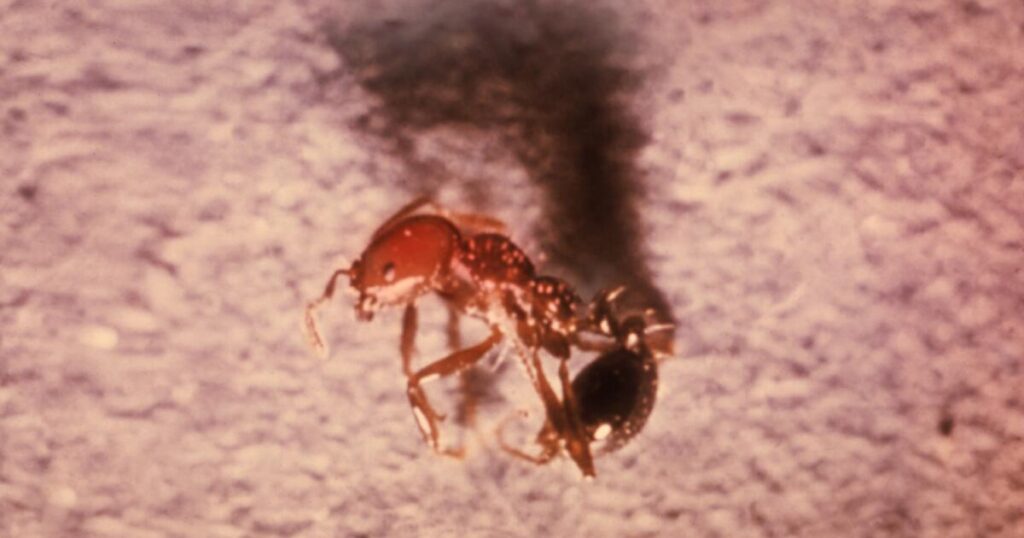A new population of “highly aggressive” red imported fire ants has been discovered at a private residence in Montecito, according to Santa Barbara County officials.
Capable of biting and stinging humans, pets and livestock, these ants are often defending their nests or colonies, according to a news release from the Santa Barbara County Agricultural Commissioner’s Office. The venom from ant bites can “cause painful pustules on the skin and can be especially dangerous or even fatal for sensitive groups or people who are allergic to the venom.”
Officials were alerted to the presence of fire ants on the Montecito property back in 2023 and have continued to monitor the area this year after fire ants were discovered in the area.
“We believe it came from a licensed seedling seller in Riverside County,” said Deputy Agriculture Commissioner Stephanie Stark. “One of the ways [the red imported fire ant] is moved through contaminated or infected soil.
The ants, native to South America, have long been a thorn in the side of pest control officials in southern states such as Texas, which spends about $1.2 billion a year trying to control ant populations. Stark said Santa Barbara County goes through a rigorous process to review produce shipped from quarantine areas infested with fire ants.
But these measures have not stopped the ants from migrating north. Santa Barbara last dealt with this invasive species in 2017, and the county may face the same situation again in the future. Stark said Santa Barbara County has spent more than $15,000 so far to eradicate the presence of fire ants.
Although fire ants do not eat produce, “they can sting people and animals and threaten wildlife. They can damage electrical equipment and may displace other native ants in an area because they can use [their venom] Siavash Taravati, an entomologist and integrated pest management consultant at the University of California, Agriculture and Natural Resources, said:
The invasive insect has been a thorn in the side of California pest control officials since they began battling the pest in the late 1990s and early 2000s. In Riverside, where Talavati is headquartered, the ants have taken up such a stronghold that eradicating them is almost impossible, he said. But he thinks Santa Barbara still has a chance to stop the spread of the virus.
“[Santa Barbara] It exists only in one area, Talavati said. “We hope to be able to eradicate it and prevent it from spreading to other parts of the county,” he said.
Inexperienced pest managers might try pouring liquid insecticide onto red imported fire ant nests, but Talavati says it’s not that simple. “If you miss a queen, she will lay more eggs later and the whole problem will arise again,” he said.
Aside from red flies, fire ants in Southern California don’t have many natural predators. The key to killing local fire ant colonies is a combination of chemicals and greasy baits, as predatory ants love protein.
“[Foragers] Feed on bait. They bring it back to the nest to feed their larvae, and to feed the queen in the colony. “These baits are designed to be slow because if they kill the ants too quickly, there won’t be enough time to pass the poison or pesticide to the queen and other members of the colony.”
At first, it may be difficult to tell the difference between red imported fire ants and sugar-loving Argentine ants, but one key difference is the aggressive nature of red imported fire ants.
Mark Hoddle, director of the Invasive Species Research Center at the University of California, Riverside, remembers the first time he encountered red imported fire ants in Louisiana, where he was searching for different invasive species on citrus trees. He accidentally stepped on a red imported fire ant nest and was soon surrounded by angry bugs, biting his legs and leaving painful red blisters on his skin.
Fortunately, Hoddle was able to walk away, but others were not so lucky. In rare cases, people have died from multiple bites from poisonous fire ants.
“[Death is] This is a risk for anyone who is susceptible to anaphylactic shock,” Hodel said.

